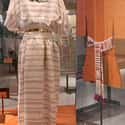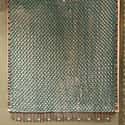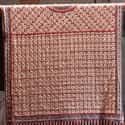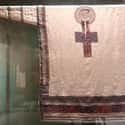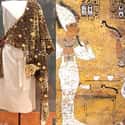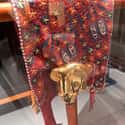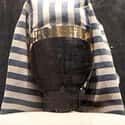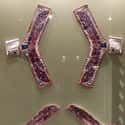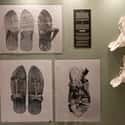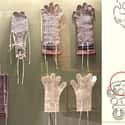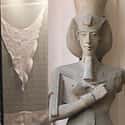-
(#1) The Tunic And Sash Combo
An ancient Egyptian tunic was made from a long sheet of linen sewn up the sides, with two holes left for arms and a large one cut in the middle for the head. The only accessories they had to hold this sheet together were sashes, which ranged from simple strips of cloth to tapestry-woven designs (right) and Amarna sashes.
A sheet and sash may sound like an easy Halloween costume, but the threads used to weave Tut's linen tunics were so fine and dense that it was difficult for the Borås Weaving School to reproduce the same sheer quality; the hand-spinning techniques needed to make such threads were quashed in most parts of the world by the Industrial Revolution. The weavers finally found linen of ancient Egyptian quality at a mill in Bergamo, Italy, where the world's top design houses go fabric shopping.
-
(#2) The Gold-Sequined Tunic
Why did Tut have so much underwear? The answer lay with his contemporary, the wealthy architect, Kha, whose undisturbed tomb held 50 loincloths and 17 tunics. By applying Kha's clothes to undies ratio, it seems more likely that Tut was buried with around 50 tunics before robbers sacked his tomb a few months after his funeral.
Mortuary priests cleaned up after these burglaries but lazily jammed clothes found on the floor into whatever box was closest. As a result, the original of this faience and gold beaded tunic spent 3,300 years in a crumpled mess, mouldering on top of random shoes and bowls. The gold weighted the heavily creased fabric, speeding its deterioration compared to undecorated textiles that were found still neatly folded in other parts of the tomb.
-
(#3) The Heb-Sed Outfit
This child-sized tunic says festival all over it. The repeating pattern of Heb-Sed hieroglyphs, most noticeable along the trim, shows that it was made specifically for Tut to attend the ruling pharaoh's jubilee celebration in Memphis, Egypt. It's the only one of Tut's garments that researchers can pin to a specific event, though it's unclear which pharaoh was celebrating his Heb-Sed. Most didn't arrange for the celebration until their 30th year of rule, though that didn't stop Tut's father, Akhenaten, who put on a Heb-Sed only three years into his reign.
Tiny Tut may have worn this garment while watching his old man prove he was still physically fit to rule by running eight times around a ritualistic track wearing nothing but the two crowns of Egypt, a short kilt, and a strapped-on bull's tail. To top off this royal track event, the pharaoh ran in the “company” of a real sacred bull named Apis.
-
(#4) The “Syrian” Tunic
This was Tut's only garment with sleeves, designed for him when he was an early teen. His crowning name, “Nebcheperture,” is tapestry woven in cartouches around the collar along with images of the tree of life, a blessing for the young king, appear on both sides of the ankh sign in the middle of his chest. The bottom of the tunic is lined with panels depicting floral palmettes, griffins, sphinxes, and hunting scenes involving dogs, bulls, lions, gazelles, and ibexes. In order to reproduce this garment, the Borås Weaving School consulted Bedouins in Egypt who still spin thread on spindles and weave similar designs on looms that haven't changed in 4,000 years.
The "Syrian" tunic was most likely sent as a diplomatic gift from Egypt's longtime trading partner, the Mitanni Kingdom located in modern-day Syria and Angola, where sleeves were all the rage. In the end, this tunic was a sad souvenir to take into the afterlife. Though Tut sent his army to defend the fashion-forward Mitanni, they were crushed by invading Hittites right around the time that Tut died at the age of 19, obliterating the Mitanni Kingdom and throwing Tut's realm into chaos.
-
(#5) The Falcon Tunic
It may look like harmless hippy-dippy beachwear, but this tunic is covered in powerful imagery. Falcon wings spread out from either side of the neck so that when Tut put this tunic on, his head became that of the sky god, transforming him into the “Living Horus.” The pretty blue flower pattern inside the red rosettes symbolized Tut's kingly authority and his ability to live forever like the sun god Re who was said to rise each morning with the opening of the lotus blossoms on the Nile.
Down the front, hieroglyphic trash talk is woven right into the fabric: "The good and mighty, son of Amun, born of great joy, who tramples all foreign lands, king of upper and lower Egypt, lord of two lands, son of Re, of his body, his beloved, Tutankhamun, ruler of the Southern Heliopolis, given life, like Re, for all eternity."
One can only hope Tut went full-on, boho-chic warrior and paired this tunic with his flip-flops that show Egypt's bound enemies on the insoles for him to crush beneath his bare feet.
-
(#6) The Leopard Skin Robe
When Howard Carter found Tut's priestly robe, the leopard skin was severely decayed, so only the golden head and embellishments survived. It was a garment reserved for the pharaoh – the high priest of all the gods and temples in the land – and his Sem priests, who wore it while performing funerary rituals.
To the right is a painting from Tut's burial chamber that shows his successor, Ay, wearing a leopard robe while performing the “Opening of the Mouth” ceremony on Tut. In this ritual, Ay assumed the role of the god Horus and Tut the dead king Osiris. Once completed, Ay became king by divine approval, and Tut, with his mouth “opened,” was allowed to eat and drink in the afterlife, ensuring the 36 jars of red wine and 48 meat mummies in his antechamber wouldn't go to waste.
-
(#7) The Faux Leopard Cloak
This small, vegan leopard cloak was probably made for Tut right around the time that he was crowned pharaoh. There are cartouches just above the gold head that bear the king's coronation name, and a Horus falcon stretches diagonally in the center. The embroidered stars in circles covering the fabric – a similar design to those on the real leopard robe – meant that it was worn at the funeral of someone important. There's a chance that young Tut wore this leopard cloak while performing the “Opening of the Mouth” ceremony on his dad and predecessor, Akhenaten.
Why is this priestly garment made from a fake skin? Apparently, Tut and his priests wore both real and fake skins for religious ceremonies. Leopards weren't native to Egypt and arrived through suppliers from neighboring countries like Nubia, whose emissaries are shown bringing tributes to the pharaoh on one of the walls of Rekhmire's tomb. If anything disrupted the leopard-skin supply chain, priests and even the pharaoh had to get creative with their religious clothing.
-
(#8) The Famous Pharaoh Hat
The striped nemes is a headdress worn only by kings and gods and is one of the oldest fashion items in ancient Egypt. It was usually held in place by a gold band across the forehead with a uraeus or cobra symbolizing divine authority and the Nekhbet vulture symbolizing the unification of upper and lower Egypt. It first appeared on a statue of Djoser, the first pharaoh of the old kingdom, 100 years before Khafra built the Sphinx and 1300 years before Tut.
Howard Carter made a note of Tut's nemes in the second coffin, describing it as "striated with lapis blue glass, much discoloured and decayed" and ended up tossing it in the trash.
-
(#9) The Mystery of the Wings
Tut's wings required more fashion sleuthing than his other clothing reproductions. Arthur Mace, who aided Howard Carter while excavating Tut's tomb, mistook them for ceremonial headdresses: “Found that so-called child's tippet' was really a head covering in the form of a protective bird with wings stretched out behind.” After reconstructing the four garments, Dr. Vogelsang-Eastwood and her students tried them on in different ways and discovered that they were upper armbands, not hats.
Tut wore these falcon wings of Horus in pairs, one on each arm with a wing draped over his front and one over his back so that his chest was completely enfolded. The Horus image may look printed onto the fabric, but the birds were constructed from individual pieces of red, blue, and white dyed linen sewn onto the base. Because the cuffs were extremely small, Tut either wore these wings when he was very young, or he had super skinny upper arms.
-
(#10) Ancient Nerd Socks
Tut's socks were a surprise find for Howard Carter because there are no representations of anyone wearing socks in ancient Egypt, period. Children went shoeless until the age of six, and after that, only wealthy Egyptians had any, and they were usually made of vegetable materials. Kha, who was rich enough to afford shoes, chose to portray himself as eternally barefoot in the statuette found in his tomb.
So, to ancient Egyptians, socks must have seemed like either a mind-blowing luxury during chilly nights, or a total nuisance. Tut's don't look particularly comfortable, stitched together from several pieces of cloth with a gap between the two biggest toes so he could wear his flip-flops year-round.
-
(#11) Gloves
Tut was entombed with 14 pairs of gloves, which is a lot for a guy who never seems to have worn them. Several of the gloves were fingerless gauntlets designed for holding the reigns of his chariot, and yet archeologists have yet to uncover a single image of Tut wearing gloves while driving his chariot or doing anything else for that matter. And Tut's gloves proved challenging to reconstruct, from the fine linen to the intricate lotus blossom pattern, so it wasn't like the ancient makers hashed them out of the cheap stuff like the socks.
The only documented case of any early Egyptian wearing gloves is Tut's successor, Ay. On his damaged tomb walls, Ay is shown receiving gloves as one of many gifts from Tut's dad, Akhenaten (circled red in his swag pile), then wearing them gleefully out of the palace to the oohs and aahs of his adoring crowd. After that, gloves went the way of socks and disappeared into the back of ancient history's closet.
-
(#12) The Pear-Shaped King
While reconstructing one of Tut's loincloths, Dr. Vogelsang-Eastwood discovered that Tut's measurements were roughly 31, 28, 43. These numbers may seem random coming from what looks like a sloppy cloth diaper, but Tut's undies were tailored to fit him with precision, and the tiny waist measurement was reinforced by his belts which fit snugly around his tunics.
There's lots of speculation about why Tut had such a feminine shape from the waist down. If there's any truth to Akhenaten's statues and wall art, Tut's dad also had round hips so it could be an inherited trait. There's DNA evidence that Tut's parents were brother and sister, increasing the possibility that in addition to a clubfoot, he suffered from a genetic illness that messed with his hormones.
New Random Displays Display All By Ranking
About This Tool
Affected by the creation of modern art, many people think that ancient Egyptian cities must be magnificent, and the costumes of ancient Egyptians must be gorgeous and diverse. In a longer historical period, the costumes of ancient Egypt from the pharaohs to the people were very simple, which can be proved by King Tut's ancient Egyptian clothing. The tomb of ancient Egyptian king Tut was discovered by archaeologists for more than 100 years, people have unearthed a large number of jewels and gorgeous funeral objects in his tomb, including many textiles.
Although they have been corroded and damaged, scientists have restored the color and appearance of these ancient costumes with the help of advanced technology. The random tool displays 12 amazing recreated garments from King Tut's ancient clothing.
Our data comes from Ranker, If you want to participate in the ranking of items displayed on this page, please click here.











